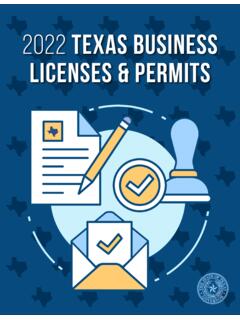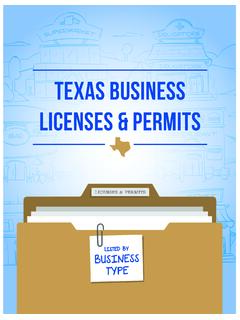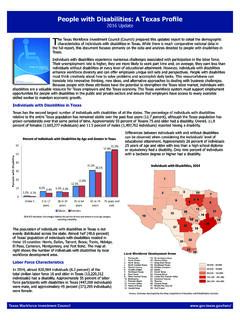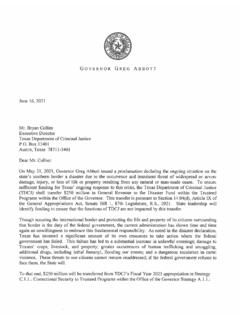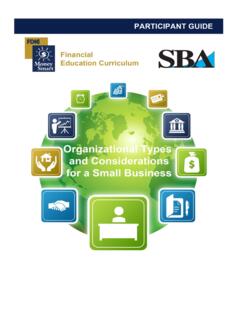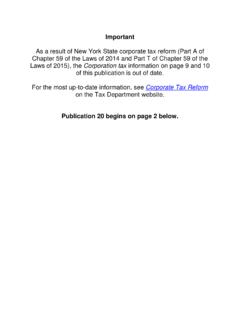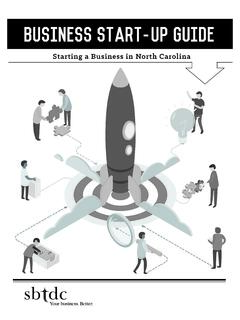Transcription of THE GOVERNOR’S SMALL BUSINESS HANDBOOK
1 THE GOVERNOR S SMALL BUSINESS HANDBOOK2 | GOVERNOR S SMALL BUSINESS HANDBOOKThis HANDBOOK is intended to provide general guidance and assistance to those interested in developing or further expanding their BUSINESS in Texas and beyond. It is not intended to be construed or relied upon as legal, accounting, or other professional services or advice. Every effort has been made to make this publication as complete as possible, but by no means can all subject matters, rules, regulations, and resources involved in commerce be covered in one document. Please be aware that the information contained herein is subject to change without notice.
2 If uncertain as to how to proceed on any given matter, legal or other professional services should be sought. This HANDBOOK was created with substantial assistance from many resources outside and inside the Office of the Governor. Every effort was made to accurately source these tools and other tools that are available to SMALL businesses in Texas. For additional copies of this HANDBOOK , or for additional information on any of the topics covered, please call 512-936-0100. The Governor s Office of Economic Development and Box 12428 Austin, Texas 78711-2428 Telephone: 512-936-0100 Fax: us | INTRODUCTIONGOVERNOR S SMALL BUSINESS HANDBOOK | 3 Page4 A Letter from the SMALL BUSINESS Team5 Preparation: Writing a BUSINESS Plan7 How to Start a BUSINESS in Texas: Overview and Registration8 BUSINESS Entity Formation & Registration18 Guide to Status Terminology Used by the Secretary of State21 BUSINESS Filings and Trademarks Fee Schedule26 Tax Responsibilities28 Licenses, Permits, and Employer Requirements30 Insurance Requirements37 Texas Workforce Commission.
3 BUSINESS Solution Programs39 Unemployment Tax41 SMALL BUSINESS Development Centers46 Veterans Resources54 Financing: Overview & Lenders73 Financing: State Programs76 Financing: Local Incentives78 Financing: federal Programs & Grants86 Interesting Facts About the Texas Economy and SMALL Business89 Texas Procurement and Support Services (TPASS)90 State of Texas HUB Certification and Eligibility92 SMALL BUSINESS Certifications (SBE/DBE/WBE): Program Overview98 Index: State BUSINESS Licenses and Permits by BUSINESS Type124 Index: federal and State Agency Contact InformationTable of ContentsINTRODUCTION |4 | GOVERNOR S SMALL BUSINESS HANDBOOKS mall businesses are an important part of the state s mission in helping keep Texas a very BUSINESS -friendly, fair, dynamic and flourishing economy one of the best, healthiest and fastest-growing in the country.
4 SMALL businesses are the backbone of our state and nation, and through collaborations with organizations like yours we help ensure that they remain a top priority and focal point of the public and private sector. We hope that this HANDBOOK will provide a resourceful foundation, inspire new ideas and expanded connections, and encourage the inception, growth and prosperity of SMALL businesses in and around your community. This HANDBOOK has been compiled to provide BUSINESS owners and entrepreneurs with the information and knowledge necessary to start or grow a SMALL BUSINESS in Texas. It contains information from various state agencies to give you a straightforward approach to your new or existing BUSINESS .
5 From registering your BUSINESS to obtaining your HUB certification, this resource has been produced to demystify the process of doing BUSINESS in Texas. In addition to utilizing this information, consider attending a Governor s SMALL BUSINESS Forum. With more than 20 forums across the state, the Governor s SMALL BUSINESS Forums are instrumental in providing information to businesses in the region. These events offer information on financing, social media, government contracting, incentives on hiring veterans, and many more facets of BUSINESS . On behalf of the Governor s Office, we wish you continued success in all of your endeavors and your enterprises.
6 Best wishes,The Governor s SMALL BUSINESS TeamLetter from the SMALL BUSINESS Team | INTRODUCTIONGOVERNOR S SMALL BUSINESS HANDBOOK | 5 Creating a comprehensive BUSINESS plan is an important process. The idea of writing a busi-ness plan may not seem important, however, it ultimately serves many important purposes. It will serve to outline the main purpose of your BUSINESS , its structure, its financing, and its ad-vantages over other market competitors. A solid BUSINESS plan can be used as a framework for your company s mission and serves as support when it comes time to apply for financing. Here are some notes about what can be included in a BUSINESS Plan: BUSINESS NameExecutive Summary: Description of the product or service that your company will sell; to whom the product or service will be sold to; how much this will cost; and how long it will take to become profitable.
7 Keep it simple. BUSINESS set-up and structure: Description of the company s BUSINESS , legal, and leadership structure. Follow this by a discussion of the company s management approach, hiring pro-cess, office and equipment needs. Include a list of the necessary licenses and permits that will be obtained. Strategic Financial Plan: Outline of how much money the BUSINESS will need and where the support will come from. Include a breakdown of the monthly budget and cash flow for the first year. Include detailed information on the current market and projected customer de-mands; pricing strategy; available financial support; anticipated financial support; costs asso-ciated with development, production, office space, employee salaries, equipment purchase, etc.
8 ; anticipated timeline for marketing; goals for profitability. *If your BUSINESS is seeking fi-nancing then you will probably be asked to provide income statements demonstrating sound financial accountability. Provide a stated goal for when the company will be profitable and what the return on the investment will be. Development and regulatory process outline: Provide a time frame demonstrating the time it will take to build, produce, and generate the BUSINESS . Include breakdown of any risk and explain why and how that will be overcome. PREPARATION: Writing a BUSINESS PlanINTRODUCTION |6 | GOVERNOR S SMALL BUSINESS HANDBOOKM arketing Plan: Provide information regarding the ideal customer; how the ideal customer will be reached; and when this will occur.
9 Provide information on the pricing strategy and why consumers will buy the product or service. Provide an overview of how marketing and outreach will serve to promote your BUSINESS so that consumers become a reality. Explain how the product will be marketed so to demonstrate a competitive edge over the other similar product or service providers in the industry. Explain the expenses involved in marketing the product and services. Biographies of all of the people on the team that demonstrates their education, experience, skills, and expertise are in line with the BUSINESS s mission. Launch and delivery plan: Discuss where the BUSINESS is going.
10 Inform readers of how in-vestors will get money out of the BUSINESS , and what the rate of return on the investment will eventually look like. Include discussion of whether the company could eventually be taken public, and what would be at risk. | INTRODUCTIONGOVERNOR S SMALL BUSINESS HANDBOOK | 7In BUSINESS , there are no guarantees. There is simply no way to eliminate all the risks associated with starting a SMALL BUSINESS but you can improve your chances of success with good planning, preparation, and insight. In Texas, SMALL businesses continue to thrive due to a variety of factors including our excellent geographic location, our highly skilled workforce, our low tax burden, our reasonable cost of living, our predictable regulatory environment, and our legacy of being Wide Open for a BUSINESS in Texas requires you to complete a number of basic steps and make some key decisions.
